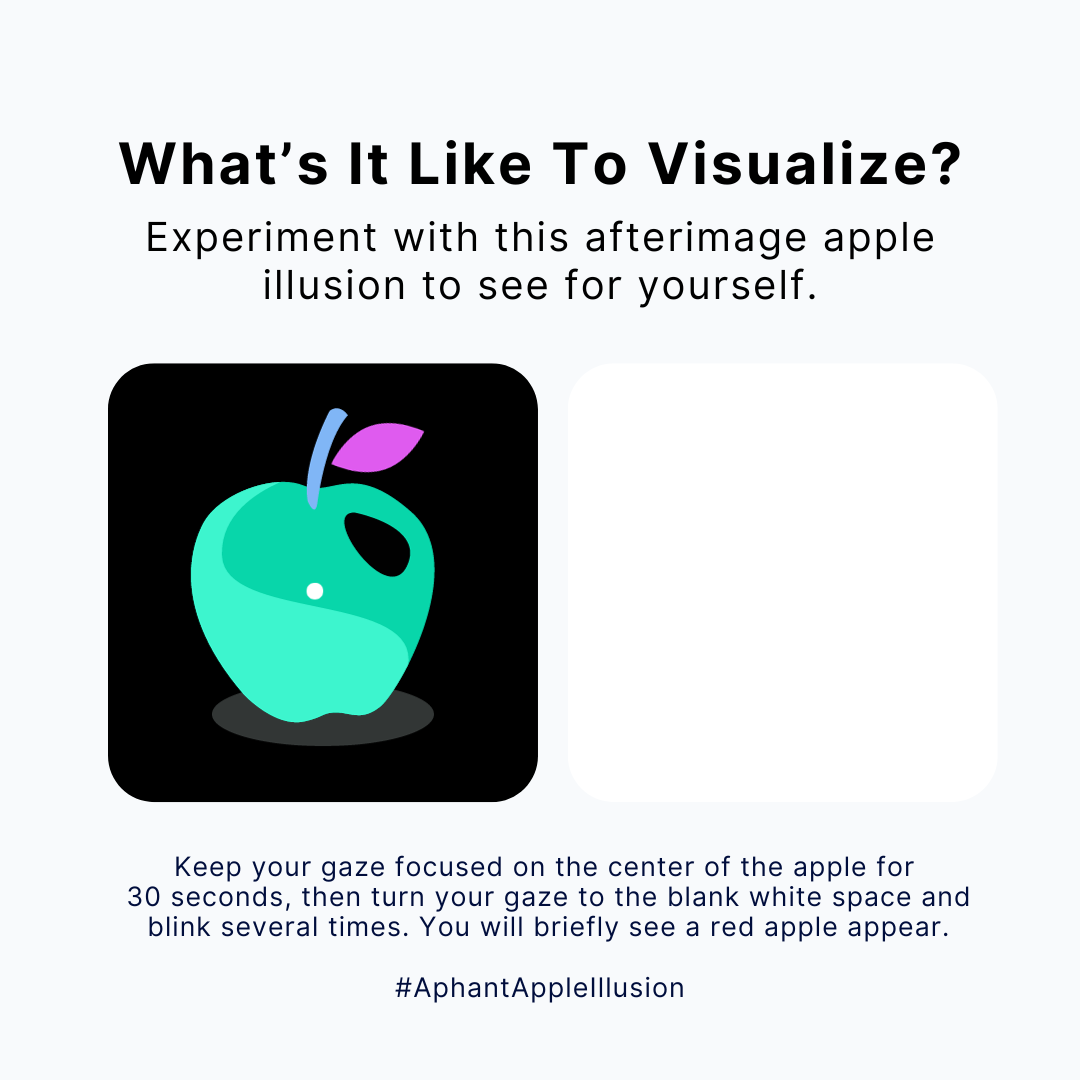The Apple Illusion: A Glimpse into Visualization
Most people—about 96%—find visualizing second nature. They think of an apple, a sunset, or a friend, and they can "see" it in their mind's eye." For many with aphantasia, this seemingly simple task remains an enigma. So how can you describe something you've never experienced? That's where the afterimage apple illusion comes into play.
This optical illusion offers a brief window into what visualization might feel like. By staring at an object for about 30 seconds, you can experience a fleeting "image" even after the object is gone—not unlike the experience of visualization itself.
This illusion is fascinating because it uses visual perception rather than imagination to create a temporary 'mental image' when the object disappears. While it's not exactly the same as visualization, it offers those with aphantasia a tangible way to understand what visualizers might experience.
How Does the Afterimage Illusion Work?
The magic behind the illusion lies in a phenomenon known as an afterimage. When you stare at an object for 30 seconds or more, the receptor cells in your eyes gradually tire out and deplete their photopigments. Your brain adapts, treating this decreasing signal as the new normal.
Then, when you look away at a blank surface, the least exhausted cells suddenly become more active—creating a "negative image" of the original object, even though it's no longer there.
This experience mirrors what visualization might feel like. Just as the afterimage lets you "see" an object that isn't physically present, visualization involves creating a mental image without the actual object in front of you. It's the mind filling in the gaps, conjuring an image where none exists.
Try the Apple Illusion
Ready to experience it yourself? Focus your gaze on the center of the apple below for about 30 seconds without moving your eyes. Then shift your gaze to a blank white space and blink several times.
You should see a faint red apple appear for 5-15 seconds—a brief, perception-based glimpse into what "seeing" with your mind's eye might feel like.
Understanding the Difference
The apple illusion offers a fascinating glimpse into visualization, but it's important to understand what makes it different from both ordinary perception and imagination.
Perception is what happens when you look at a real apple in front of you—your eyes take in the sensory information in real-time.
Visualization is when you close your eyes and create a mental image of that apple using your imagination and memory. For most people, this feels vivid and visual.
The afterimage illusion sits somewhere in between. It uses your visual system (like perception) but creates an image of something that's no longer there (like visualization). That's what makes it such a useful bridge for understanding what visualization might feel like—especially for those with aphantasia who can't create those mental images voluntarily.
Hyperphantasia and the Spectrum of Imagination
Aphantasia represents one end of the visual imagination spectrum. At the opposite end lies hyperphantasia.
The visualization spectrum:
Aphantasia: No voluntary mental imagery
Typical visualization: Moderate, less detailed mental images (most common)
Hyperphantasia: Exceptionally vivid, almost perception-like mental images
What is Hyperphantasia?
People with hyperphantasia can create remarkably detailed mental images. Imagine not just thinking of an apple but seeing every detail—the shiny reflection on its skin, tiny imperfections, even subtle color variations. For someone with hyperphantasia, a mental image can be nearly as crisp as looking at a real apple.
Here's what many people don't realize: most visualizers don't experience this level of detail. Despite what movies and pop culture suggest, the average person's mental imagery is only moderately vivid—somewhere in the middle of the spectrum.
Associators vs. Projectors: Where Do You "See" Your Mental Images?
Beyond how vivid your mental images are, there's another fascinating dimension: where you experience them. Researcher Samuel Schwarzkopf describes two distinct modes of visualization—associators and projectors.
Projectors perceive their mental images as if they're superimposed onto the real world. When they visualize an apple, they might "see" it floating in the space in front of them, almost as if it's actually there. Their imagination and perception can blend together.
Associators experience mental images differently. They have clear visual imagery, but it feels like it's happening "in their head" or "behind their eyes"—separate from what they're actually seeing. The imagined apple doesn't interfere with their visual field.
Most visualizers fall somewhere along this spectrum, and many don't even realize there's a difference in how people experience mental imagery.
What the Apple Illusion Teaches Us
While the apple illusion comes from perception rather than imagination, it offers a rare bridge to understanding visualization—especially for those who can't create mental images voluntarily.
The key insight? Human visual imagination exists on a spectrum. No single analogy can capture every variation of visualization, but experiments like this help us appreciate the cognitive diversity of human imagination.
Reflect on Your Experience
Whether you have aphantasia, hyperphantasia, or fall somewhere in between—how did you experience the afterimage?
For aphantasics: Did this give you insight into what visualization might be like?
For visualizers: How did this compare to your typical mental imagery? Do you tend to see images "in your head" (associator) or overlaid on the world around you (projector)?
I'm curious about your experience—drop a comment below and share what happened when you tried the illusion!

